By: Michael_Noonan
Not that charts actually "speak," but the information taken from them can be the most reliable for anyone wanting to accumulate profits. Does not everyone want to accumulate profits? You would think that the answer would be an easy yes, but somewhere in the process of "investing" in the stock market, the answer is not as obvious as it would seem.
Why not?
Good question.
Lack of discipline is one of the more key answers. Ignorance comes to mind as a more widespread one. Too many people simply do not know what to do at the right time or at critical moments. When a stock or a futures contract is not going well, aka creating losses, the first question, it would seem, is what was the plan? What was the reason for entering into a position in the first place? What was the exit plan,[surely there was one]?
If there were no specific plan, a set of reasons for entering, and a plan of action for exiting, then ignorance becomes a primary factor. Ignorance is a noun meaning lack of knowledge or information. One can be somewhat lacking in knowledge, but with discipline and a plan, then the odds of success increase dramatically.
What does this have to do with charts? They provide a visual map for negotiating through the ups and downs in any market. Charts are the ultimate distillation of all available news and information. Everyone who makes a decision to buy or sell in the market leaves a mark. The culmination of all the "marks" left behind in the course of a trading day, [or any time frame], results in a high and low price, and eventually a closing price, forming a bar. Attendant with each bar is the amount of transactional volume, providing yet more info.
We may not be invited to learn the plans of moving a market by what can be called "smart money," the primary market influence[ers], but with price and volume, found in charts, but we can follow the "marks" they leave behind. To move any market requires strength in buying, and volume to provide price energy, [in an up market; the opposite in a down market]. The momentum developed in this process creates a trend. Solution? Follow the trend.
What we are seeing right now is a possible change in trend. The daily trend has turned down. The weekly trend has not. A conflict? Not really. One just needs to be aware of the primary trend under consideration.
The steeper a trend line, [TL], the more it is subject to a break, especially in the advanced stages of a trend. The poor close last month, 2nd bar from end, on low volume was a red flag for a lack of demand. In June, volume has picked up significantly, as price declined, another and bigger red flag.
A red flag is reason for caution and a clue to look at smaller time frames for change.
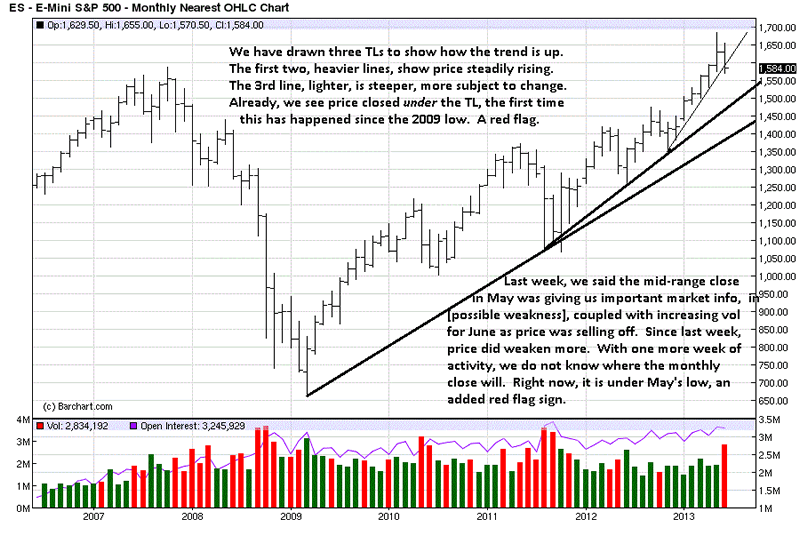
The sharper angle TL has been broken. The poor close on the high of this rally was a red flag, a clue that led to May's poor close for the month on above chart. It was followed by another down bar. The next bar, 3rd from the end, shows a rally effort, but results were weak, especially since volume, [effort] increased, yielding no payoff for the increased effort. You can see how a chain of trading days, since the red flag high, continues to show signs of weakness when the market should be strong, at highs.
There appears to be a momentum shift in progress. All we are doing is making factual observations that lead to logical conclusions. No guesswork is involved. It tells investors to take profits, certainly get rid of losers that can become bigger losers, and tighten stops on all other positions. For futures traders, it may be signaling shorting opportunities.
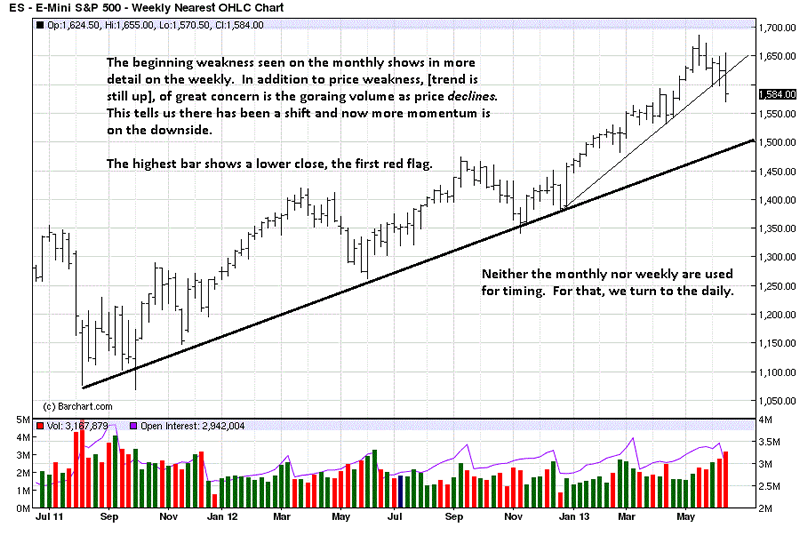
The weak rally lead to a lower high that was followed immediately by a wide range down bar on increased volume. The lower low confirms the change of trend. How the lower low is created give more information. The decline shows Ease of Downward Movement, [EDM], indicating a strong shift in momentum. Any rally that shows weakness can become a great shorting opportunity.
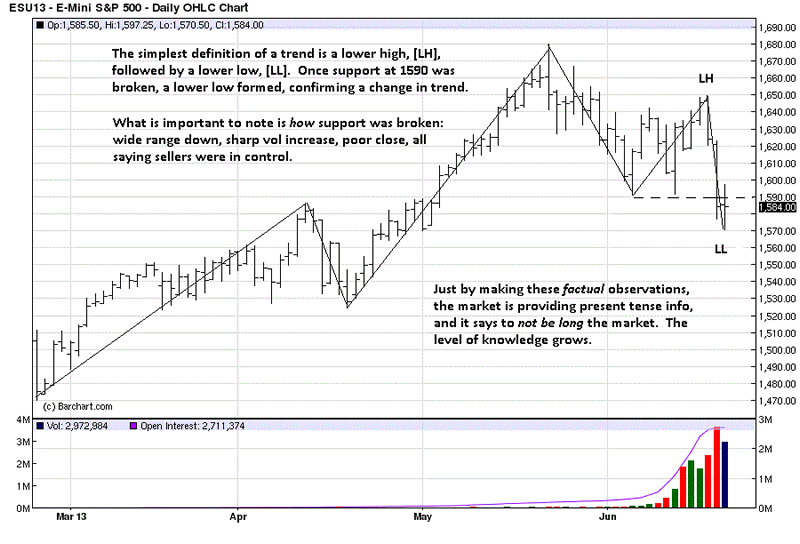
The NAS had been leading the S&P, in general, and it, too, is exhibiting weakness signs.
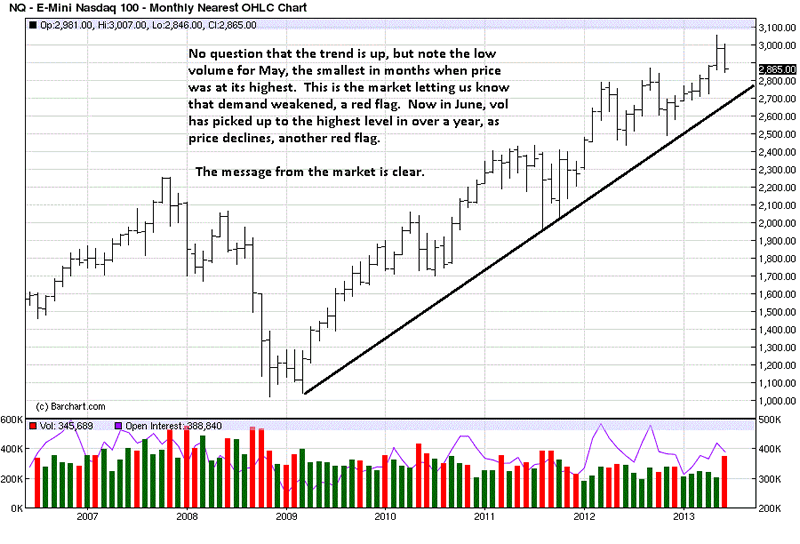
This larger chart of the weekly shows for how long it has been trending up. It takes time to turn a trend, so there is no reason to be panicking, but concern of longs can be heightened.
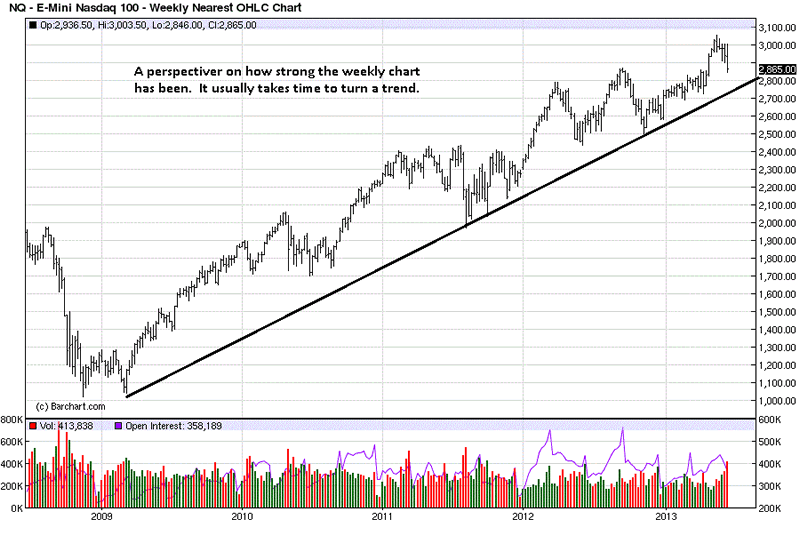
A closer look at the weekly shows how volume has increased dramatically as price began to decline, a significant change in market behavior, and a larger red flag.
We noted the last swing high, [arrow], was topped by a tiny range bar, a sure sign of a lack of demand. The trend did resume after a 8 week decline, and it is still possible that the current decline may yet lead to another leg up to new highs.
What is important is that we do not need to know what will develop/happen in advance. All we need do is focus on the smaller time frame developing activity and respond to the signs that determine how to position, based on facts, as mentioned on S&P daily.
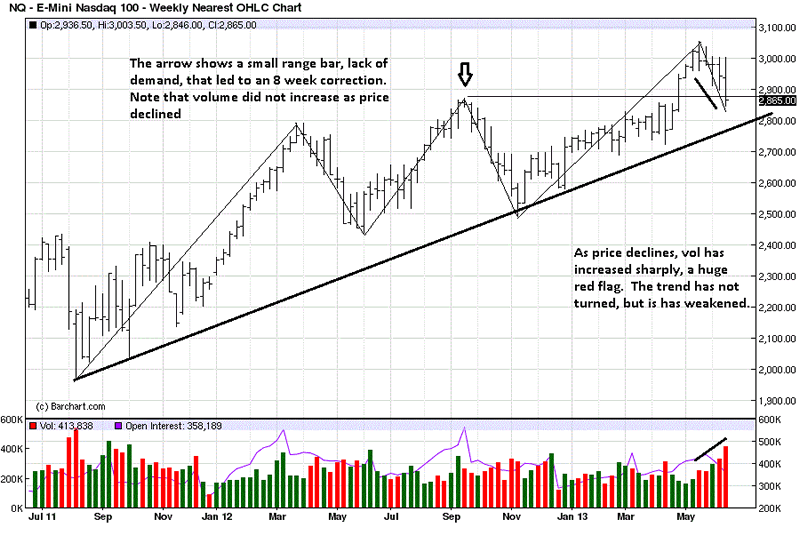
No comments:
Post a Comment